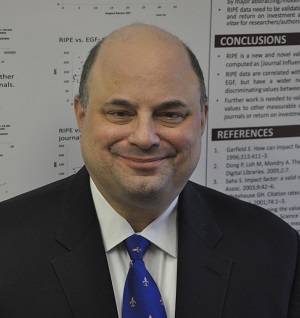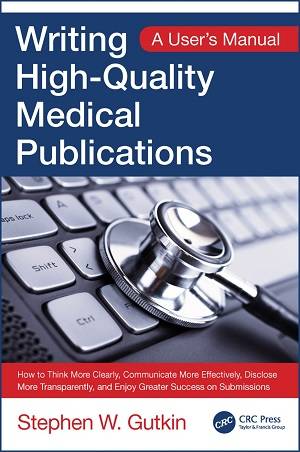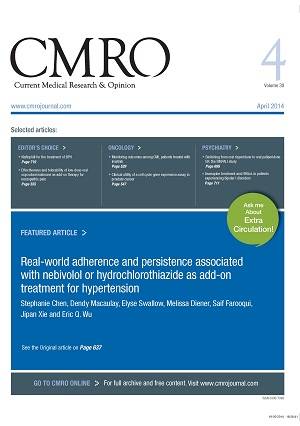CRC Press is pleased to share our Q&A session with author Stephen Gutkin to celebrate the publication of his new book Writing High-Quality Medical Publications: A User's Manual which is available to purchase either as paperback or hardback.
About the book and your subject area
Congratulations on the publication of your book Writing High-Quality Medical Publications: A User's Manual. What do you want your audience to take away from the book?
Millions of manuscripts for peer-reviewed journals are undertaken each year, usually without a clear path to publication. In fact, the likelihood of seeing one’s paper published in such a journal, without being retracted or cited only a handful of times afterward, is not much greater than the play of chance. I want aspiring writers to know that my textbook will help to “even the score” (or, given my UK publisher, “level the pitch”). Cynics maintain that publishing a paper is an ultimately unrewarding, or even soul-depleting, enterprise. By sharing time-honoured principles and examples of manuscript quality; enjoyable “before-after” exercises in prose style; and a chapter to teach biostatistics in a practical, “hands-on” manner, I seek to render authors’ contributions more acceptable to their journals of first choice.
What inspired you to write this book?
Versions and components of the “Gutkin Manual” served as a standard operating procedures and style manual for my medical-communications group for 23 years, during which our collaborations with more than 500 investigators and other scientists in industry and academia, from São Paulo to Shanghai, culminated in 200 papers published in peer-reviewed journals: mainly ones of our first choice.
By sharing examples and exercises informed by my 30-year practice in medical publications, I am confident that I can help many practitioners not only to think more clearly and scientifically but also to interpret data more dispassionately and write more elegantly and memorably.
A further source of inspiration is the CRC Press imprimatur that my book will carry. I undertook this endeavour with an abiding respect for, and inspiration by, the publisher and series. From my days in high-school inorganic chemistry, to organic chemistry at Duke, I often consulted a CRC Press textbook to learn a needed coefficient or other data. In a similar manner, the “Gutkin Manual” aggregates indispensable writing guidelines, exercises, templates, and other important information to promote the success of manuscript submissions to peer-reviewed journals.
What audience did you have in mind whilst writing you book?
This is an important question, in part because my textbook emphasizes the enduring value, to any accomplished writer, of being mindful of her readers’ perspectives and needs. From the onset of translating my company’s style manual into a textbook, I have intended it to be read by the widest possible swath of practitioners: providing basics of measures of central tendency and dispersion to the relative “newbie”; and Bayesian statistics, sample size calculations, sources of bias, propensity score matching, and mixed models to the more sophisticated trialist or other scientist.
“Medical writer” need not be a contradiction of terms but is arguably a dyad: some practitioners reside more in the “medical” domain, whereas others tend to inhabit the “writer” province. For many scientists, English is not the native language. With this duality in mind, I have ensured that the “Gutkin Manual” methodically inculcates “greater literacy in the numerate and greater numeracy in the literate.”
What makes your book stand out from its competitors?
With all due respect, and in all self-modesty, I don’t believe that the “Gutkin Manual” has a competitor as a "how-to" guide to research, write, and edit manuscripts for publication in peer-reviewed journals. Style manuals abound. Many are known by their authors’ names: Strunk and White, Follett, Fowler, and Huth, to name a few; not to mention the American Medical Association’s Manual of Style (currently in its 10th edition) and Chicago Style Manual. I am even of a certain vintage to remember Words into Type, whose final version (third) debuted in 1974.
These textbooks have undeniable utility and, in fact, my textbook’s “Diction-err-y” (of “plural effusions” and other lapses) pays homage to certain primers on English usage.
Yet the “Gutkin Manual” is much more: a practical, eminently readable guide to the medical writer confronted with the blank page. To my knowledge, it is unprecedented in providing the following facets within a single volume:
• A step-by-step guide to writing reports of many studies with different designs, including randomized controlled trials, observational (noninterventional) studies, systematic reviews and meta-analyses (including generation of forest and funnel plots and computing heterogeneity as I2), and health-economic analyses; along with “before-after” exercises in prose style “ripped” from my own practice as an editorial manager (in Chapter 2).
• A methodical consideration of biostatistics that begins with basic scientific logic (and defects in human logic, including 60 forms of bias), error, and confounding; proceeds to data distributions and study designs, including their potential strengths and limitations; then walks through old-school “pencil-and-paper” (and Excel-driven) exercises to leave the reader with an abiding sense of the inner workings of tests otherwise consigned to the nearly proverbial statistician’s “black box” (in Chapter 3).
• A compendium of editorial quality-control (QC) checklists to prepare reports of most types of scientific studies, from preclinical (ARRIVE) investigations to meta-analyses of clinical trials (PRISMA); COPE flow diagrams to guide editorial conduct in a setting of suspected misconduct; as well as disclosure forms, correspondence, and other templates to facilitate manuscript submission, which can be a highly time-consuming process otherwise (in Chapter 4).
• A multipage table presenting approximately 80 minimum clinically important differences (MCIDs) for debilitating and disabling conditions, studies of which often include patient-reported outcome measures (PROMs; in Appendix 1).
What did you enjoy about writing the book?
One of the initially latent joys of writing my book related to biostatistics. Many, even very accomplished researchers and other scientists profess (or feign) ignorance in this realm. Yet statisticians often hold the “keys to the kingdom” of medical research, largely dictating the way a study is conducted and its findings are interpreted and communicated. In my research, I found that ways in which tests are conducted are largely determined by answering a few, very fundamental questions related to the contours (or expected distributions) and overall nature of data: categorical, or continuous; paired, or unpaired (independent); and normally, or non-normally distributed? I then learned that practitioners need look no further than their own PCs to perform a wide range of biostatistics and tests, including mean, standard deviation, skew, Student’s t-test, analysis of variance (ANOVA), correlation, and linear regression; projecting sample sizes in trial design; and performing Kaplan-Meier, forest, and funnel plotting.
Adding to the satisfaction of these discoveries were the intriguing stories that inform the development of various statistics (and are captured in my textbook). For instance, the Poisson distribution, which characterizes unlikely events, initially derived from 19th-century scientists’ seeking to explain especially infrequent ones, such as numbers of cavalry killed by their own horses’ kicks. Many of us are aware that the “Student” of Student’s t-test is a pseudonym for William Sealy Gosset but don’t know that he was an English agrostatistician who devised his test whilst searching for bumper barley crops for his employer, Guinness (of Guinness stout fame). Finally, many of us have heard of Sir Ronald A. Fisher but don’t know that he was the paterfamilias of both randomization and ANOVA and devised his Exact Test as a hypergeometric formula to prove, with 98.6% confidence, that a proper English lady (Dr. Blanche Muriel Bristol) could not reliably discern whether tea or milk was poured first into her afternoon beverage. Sir Ronald couldn’t, enabling Dr. Bristol to reject a null hypothesis and paving the way for what the “Gutkin Manual” calls “Fisher’s Tea Test”!
What 5 tips from your book could you share to help aspiring medical writers get their book accepted by journal of their first choice?
Key “take-away” activities to foster journal acceptance include:
1. Finding one’s voice as a writer, fashioning prose that is succinct yet varied and memorable.
2. “Only connecting” (with apologies to E.M. Forster) with one’s readers, not only by reading a journal’s author instructions and reviewing the publication’s Aims and Scope but also steeping oneself in its online content and other state-of-the-art reviews and literature, as informed by authors (or coauthors).
3. Cultivating and maintaining a bond with a paper’s corresponding author, who almost always has a strong sense of reader perspectives and “breaks ties” when researchers or other authors are at loggerheads.
4. Following consensus guidelines for manuscript preparation, including CONSORT for randomized controlled trials, STROBE for observational studies, and PRISMA for systematic reviews and meta-analyses, as well as guidance from ICMJE, COPE, and GPP3 concerning author requirements and publication ethics. For the first time in one textbook (to my knowledge), the “Gutkin Manual” aggregates more than 50 QC checklists, templates, and forms from these and other authorities and guidelines.
5. Becoming better versed in biostatistics, in part because, in the words of the great Karl Pearson, “statistics is the grammar of science,” and in part because any fair-balanced discussion must weigh both potential strengths and limitations of a study design and findings.
About you:
Tell us more about your academic and writing background? What first attracted you to this topic as an area of study? Tell us an unusual fact about yourself and your teaching or writing style?
To begin to answer these questions, I refer to the preface of my textbook:
“Despite eclectic interests, medical writers share unstinting affinities for science and letters. In my case, the 'letters' first included telegrams and postcards. One of my earliest memories involves sorting through a box of scrupulously handwritten letters franked from exotic locales. My father, his mentor Norman Lasker, MD, and their co-workers had published a paper (on plasma renin activity in end-stage renal disease) in a peer-reviewed medical journal. Intrigued researchers from around the globe were posting my dad concerning the study’s merits, limitations, and implications.
The experience left a lasting impression on an intellectually curious 8-year-old. By publishing an article in a medical journal, one connects to a larger intellectual community—clinicians and other scientists eager to test, challenge, corroborate, and/or apply one’s findings in new ways.”
For as long as I can remember, I have been animated by great science and writing, and especially their nexus: clearly formulated study designs and both elegantly and memorably expressed findings, concepts, and theories. While excelling at advanced-placement biology in high school, I was also reading late rhetorician and political pundit William Safire’s “On Language” column in the New York Times (and would later see my work published in that very same column). While at Duke University, I spent time not only sweating out Grignard synthesis but also conducting an early interview with the celebrated men’s basketballers’ “Coach K” (Mike Krzyzewski) and hanging out in what we called the “comp shop,” where, through some “Medieval” process that antedated computers, ribbons of words were cut using x-acto knives and then “stuck up on boards” with warm and viscous wax. It would not be much of an exaggeration to say that I developed a nose for both organic solvents and the greasy scent of the printing press.
As a young adult, I spent 4 years in an analytical-chemistry laboratory, devising HPLC and GLC assays for endogenous biomolecules and therapeutic drug monitoring by day; and serving as an arts critic with a Brooklyn newspaper by night, learning basic journalistic principles that inform the prose style guidance in my textbook, (My service to a Brooklyn newspaper is probably the only thing I have in common with Walt Whitman!)
The happy convergence of science and writing in my own life came when I collaborated with my laboratory director on a manuscript, then, after leaving the lab, encountering the very same paper on my copydesk at McGraw-Hill Healthcare! That paper was arguably my first published manuscript. My experience with McGraw-Hill, where I supported brilliant editors (including the late and great Ellen H. Datloff), paved the way for later successes in my freelance career.
What would you say is the easiest aspect of writing?
I conceive of writing in different functionalities. To me, the easiest is “descriptive,” for instance identifying and harmonizing distinct lines of evidence to characterize a problem, such as a disease that is suboptimally diagnosed or treated. More challenging is “critical” or “analytical” thinking and writing, which challenge the writer to winnow, and weigh countervailing evidence to arrive at a unique and memorable synthesis. Although arduous, doing this harder work may result in more frequent citations, which comprise the currency of medical writers’ outputs. In Chapter 2 of my textbook. I refer to the US political pundit (and former speechwriter for president Jimmy Carter) Chris Matthews and his telecast termed “Hardball,” which concludes with a segment called “Tell Me Something I Don’t [Already] Know.” Especially in the Introductions of their essays, many writers regurgitate widely published facts rather than dig a bit deeper. For instance, which statement about stroke (cerebrovascular incident) is more memorable: that 795,000 Americans have a stroke each year, or that stroke is the leading cause of serious, long-term disability in the United States? Although each statement has its place, the latter strikes me as more lasting and hence more likely to be cited—on a hospital ward or in an OT or PT clinic as much as by other published authors.
Any advice you would like to give to aspiring writers?
I might very humbly offer the following words. Paralleling the process of your own overall personal and intellectual development, “finding your voice” as a writer, and your overall place in the world, takes time. Be patient, enjoy the self-discovery and other delights along the way, and try not to internalize other people’s agendas or ideas about timetables and the like. Work hard, be respectful and, if you excel, all manner of brilliant, kind, and thoughtful scientists and editors will happily beat a path to your door.
Do you have plans for future books? What’s next in the pipeline for you?
Next on my intellectual agenda is a software package that I’ve been contemplating and working on for decades. I’m hopeful that it too will help researchers and writers.
What is the last piece of writing that inspired you?
Work by the late Stephen Jay Gould, a Harvard biologist, inspired me by its use of the vernacular to convey more complex scientific concepts. For instance, I will never forget Gould’s explanation of evolution by reference to baseball and the reasons why nobody bats .400 anymore. Such a clever and effective device! Perhaps I have weakly approximated such effects in my own textbook, which colorfully considers kopi luwak (Asian palm civet “dung coffee”) to explain confounding (with directed acyclic graphs to clarify further), as well as citing the comedic actor Danny DeVito and former NBA star and current TV commentator Shaquille O’Neal to help understand mean and standard deviation (SD): Danny is 3 SDs below the US mean adult population height, and Shaq is 5 SDs above it!
Anything else you would like to add?
I’m a co-author of 14 papers, including the following published in Taylor & Francis journal Current Medical Research and Opinion:
Assmann G, Kannenberg F, Ramey DR, Musliner TA, Gutkin SW, Veltri EP. Effects of ezetimibe, simvastatin, atorvastatin, and ezetimibe-statin therapies on non-cholesterol sterols in patients with primary hypercholesterolemia. Current Medical Research and Opinion 2008;24:249-59.
Jacobson TA, Gutkin SW, Harper CR. Effects of a global risk educational tool on primary coronary prevention: the Atherosclerosis Assessment Via Total Risk (AVIATOR) Study. Current Medical Research and Opinion 2006;22:1065-73.
Jameson K, Zhang Q, Zhao C, Ramey DR, Tershakovec AM, Gutkin SW, Marrett E. Total and low-density lipoprotein cholesterol in high-risk patients treated with atorvastatin monotherapy in the United Kingdom: Analysis of a primary-care database. Current Medical Research and Opinion 2014;30:655-65.
Van Ganse E, Laforest L, Alemao E, Davies G, Gutkin SW, Yin D. Lipid-modifying therapy and attainment of cholesterol goals in Europe: the Return on Expenditure Achieved for Lipid Therapy (REALITY) study. Current Medical Research and Opinion 2005;21:1389-99.
Find out more about Taylor and Francis Journal: Current Medical Research and Opinion

Writing High-Quality Medical Publications : A User's Manual, 1st Edition
Author(s): Stephen Gutkin
Price: $56.95
Cat. #: K29119
ISBN: 9781498765954
Publication Date: August 24, 2018
Binding: Paperback
Request e-Inspection Copy »
About Stephen
Stephen W. Gutkin is a medical communications professional who has 30 years of experience in medical writing, editing, and editorial management, and publication planning and execution. A coauthor of 14 papers in peer-reviewed journals, Mr. Gutkin served as President of Rete Biomedical Communications Corp. for 23 years, during which the organization consulted widely with industry and academia. A summa cum laude graduate of Duke University, Mr. Gutkin served as arts critic for the Brooklyn Paper; research scientist for a toxicology laboratory that also assayed psychiatric biomarkers; and as copy chief with McGraw-Hill Healthcare (New York). He has delivered invited lectures on medical writing at Johnson & Johnson and the Center for Business Intelligence (now CBINET). Mr. Gutkin is a member of the American Association for the Advancement of Science, American Medical Writers Association, International Society for Pharmacoeconomics and Outcomes Research, and The Phi Beta Kappa. He resides in Midland Park New Jersey, with his wife, son, and colorful pet managerie.




